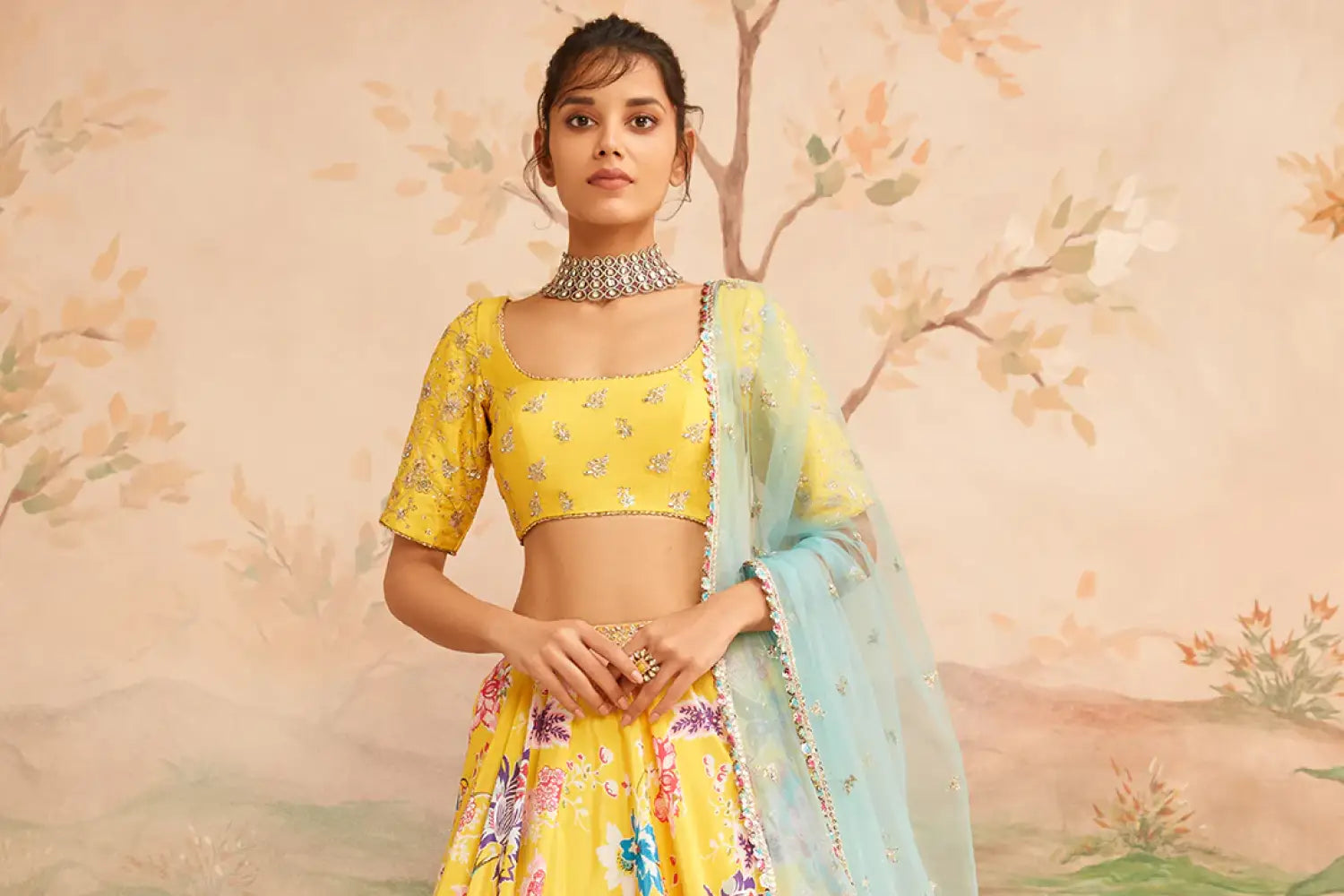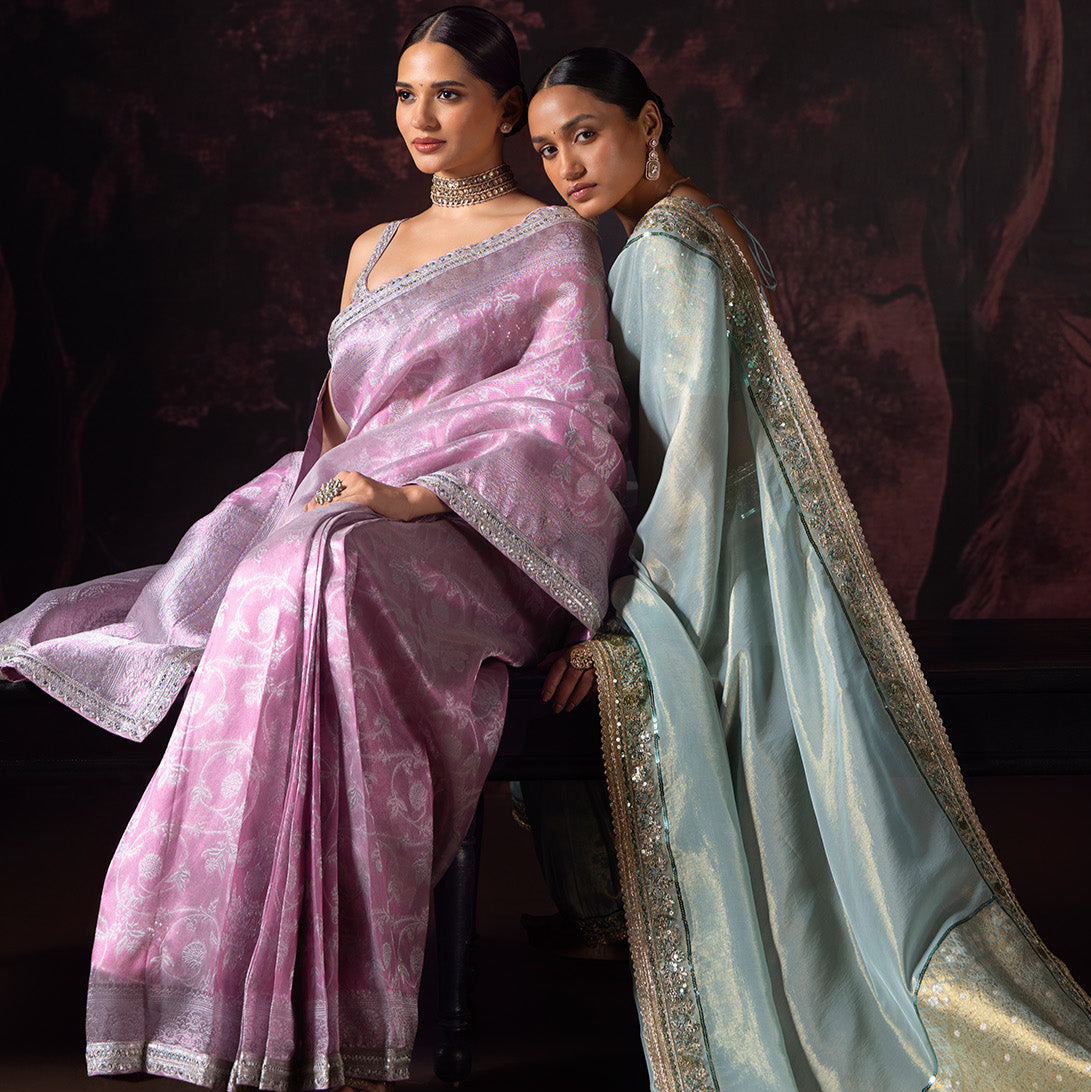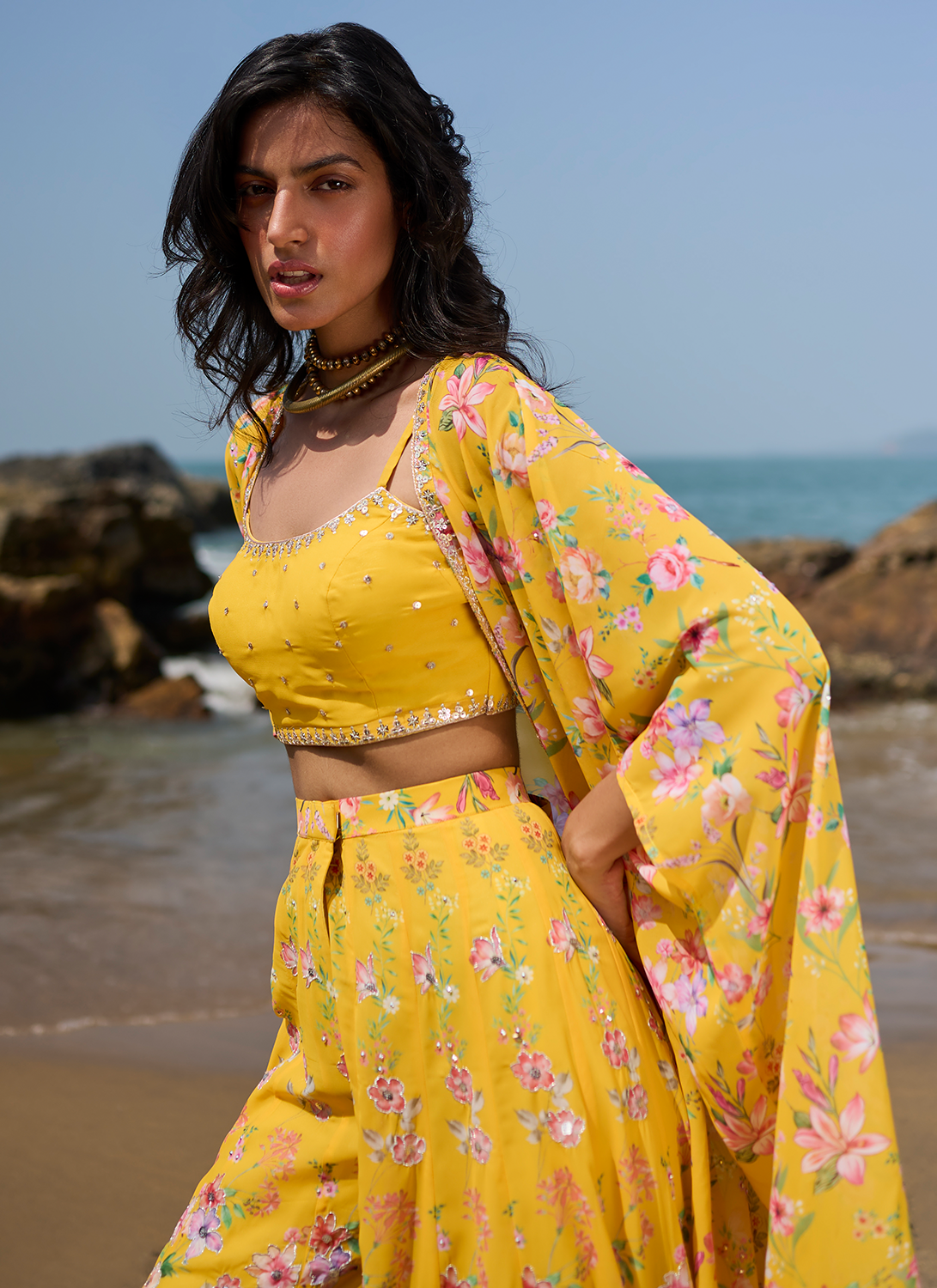
What Do Guests Wear To A Haldi Ceremony?
With wedding season back in full swing, it’s time to revamp and upgrade your festive wear closet. The bride’s outfit planning may be an excruciating affair but guests have a myriad of options to choose from. Among the many ceremonies that Indian weddings have, one of them and perhaps the first function in many Hindu rituals is the Haldi ceremony.
Understanding the Haldi Ceremony

The Haldi ceremony, also known as the turmeric ceremony, is one of the most joyful and vibrant pre-wedding events in Indian culture. Celebrations are filled with laughter, music, and the playful application of turmeric paste.
Turmeric, or haldi, in Hindu, has ancient roots in Vedic traditions for its many benefits and holds symbolic resonance in South Asian cultures. The pre-wedding turmeric ceremony brings prosperity and blesses the couple with a radiant glow before their wedding.
Also known as ‘Pithi’ in some regions of India, lively ritual holds immense cultural significance, symbolizing the purification of the couple before their big day and infusing their journey with positivity and blessings. The atmosphere is lighthearted and festive, often taking place outdoors or in beautifully decorated settings with marigold flowers, fairy lights, and colorful drapes.
Finding your Haldi outfit as a guest is all about embracing that same energy. In this guide, we’ll explore Haldi fashion do’s and don’ts for guests, including the best colors, styles, and tips to blend in with the extravagance while also ensuring comfort.
Understanding Haldi Ceremony Dress Codes
Whether you are attending as a close family member, a dear friend, or an extended guest, the dress code is typically informal since its a time of fun and celebration. While there are few key things to keep in mind when choosing your ensemble, following these tips will ensure comfort and tradition to honor the spirit of this special event!
Colors to Choose & Avoid
Haldi ceremonies are synonymous with bright, happy hues, with yellow and gold being the most popular and traditional choice. Yellow represents positivity, prosperity, and purity, making it the go-to color for this event. Other bright and cheerful highlights like orange, pink, green, or red will match the festive spirit.
However, guests can also opt for pastel tones such as peach, mint green, soft pink, or ivory, which complement the event’s aesthetic and create a fresh, elegant look. These shades are visually appealing and align well with the ceremony's overall cheerful and radiant atmosphere.
While wearing darker shades is not forbidden, guests should try to avoid colors like black or deep reds, as they do not resonate with the auspiciousness and lighthearted spirit of the event.
Comfortable Fabrics
Breathable and lightweight fabrics are ideal for Haldi ceremonies, especially since they often involve a lot of movement, dancing, and, sometimes, outdoor settings. Fabrics with subtle embroidery, floral prints, or mirror work can add a festive touch without overwhelming the overall simplicity required for this occasion.
Cotton, georgette, chiffon, and linen are all excellent choices, offering both comfort and style. Flowy outfits allow for easy mobility, making participating in the fun and festivities more convenient.
Practical Haldi Outfit Tips
-
Since Haldi ceremonies can get messy due to the turmeric application, it is advisable to avoid fabrics that stain easily or outfits with heavy embellishments that might be difficult to clean.
-
Opt for fuss-free silhouettes! Choosing simple, elegant silhouettes over stiff and structured garments ensures ease of movement while maintaining a graceful look.
-
Given that haldi paste will be applied during the ceremony, keep your makeup light and minimal.
-
Coming to the most important part – footwear – one must go for comfortable juttis or sandals that are a practical choice, as they allow you to dance and participate in the festivities with ease.
Haldi Outfit Ideas for Women Attendees
While the bridal Haldi outfits are go all out for their big day, when it comes to showing up as the wedding guest or the bridesmaid, there are several aspects to consider. How much is too much? The ceremonial occasion is where you can go easy with embellished work and incorporate warmer tones that go along with the theme.
Women have many options when dressing for a Haldi ceremony. Light and breezy sarees in fabrics like chiffon, georgette, or organza offer a traditional yet relaxed look, making them a perfect choice for the occasion. Opt for sarees with delicate embroidery, floral prints, or subtle shimmer to add a touch of glamour without going overboard.
Draping a saree in a slightly unconventional way, such as a pre-stitched or dhoti-style drape, can make for a modern and stylish statement. A comfortable salwar kameez set in cotton or silk featuring intricate threadwork, mirror embellishments, or gota patti detailing can be another great option. This outfit allows ease of movement while keeping you stylish and festive.
For those who prefer a youthful and modern look, a simple, flowy lehenga with a crop top or short kurta adds charm and grace. Floral-printed or lightly embroidered lehengas in pastel or bright tones strike the perfect balance between trendy and traditional.
If you love fusion wear, a palazzo set paired with a crop top or an Anarkali dress with ethnic motifs can make a striking statement. Indo-western outfits, such as a cape with a jumpsuit or a dhoti-style pant set, can offer a refreshing and chic alternative to classic ethnic wear.
Three Haldi Looks from Lashkaraa for Women
For a stunning and effortlessly chic look, a Yellow Floral Printed Crop Sharara Set is an excellent choice. This ensemble strikes the perfect balance between traditional charm and contemporary style. The intricate floral prints exude a fresh and lively vibe, making it an ideal pick for a Haldi ceremony.
Its flowy silhouette allows for ease of movement, ensuring you stay comfortable while partaking in the joyful festivities. Pair it with delicate jewelry, such as floral earrings or lightweight chandbalis, to enhance the elegance of the look.
If you prefer a more dramatic and eye-catching ensemble, consider a Yellow Multicolor Floral Printed Lehenga. This outfit, adorned with a vibrant mix of colors and bold patterns, is perfect for those who wish to stand out while embracing the spirit of the Haldi tradition. The graceful movement of the lehenga, coupled with its festive hues, makes it a striking option for dancing and celebrating. Complete the look with a statement maang tikka or adorn your hair with flowers.
For those who appreciate timeless elegance, a Yellow Embroidered Crepe Silk Anarkali is a regal and refined choice. The luxurious crepe silk fabric, delicately adorned with intricate embroidery, exudes an air of grace and grandeur. This outfit is perfect for guests who want to maintain a traditional yet striking appearance at the ceremony. Style it with a sheer dupatta and embroidered juttis to complete the look.
Accessories should be kept minimal—floral or pearl jewelry enhances the natural beauty of your outfit, while juttis or kolhapuris ensure both style and comfort. A small, embroidered potli bag adds a touch of ethnic elegance and completes the look. Adding fresh floral accessories, such as gajras or floral tiaras, can elevate your ensemble, making it more festive and in sync with the traditional aesthetics of the event.
Haldi Outfit Ideas for Male Guests
Men can embrace the festive charm of the Haldi ceremony while keeping their look stylish and comfortable. A classic cotton or linen men’s kurta set in shades of yellow, beige, or pastel hues serves as an effortlessly elegant choice. Pair it with pajama pants, churidars, or dhoti pants for a traditional yet relaxed appearance.
For a semi-formal ethnic style, a pastel or white linen shirt paired with chinos or loose trousers creates a refined and polished ensemble. Those looking for a contemporary twist on traditional wear can opt for Indo-western tunics or asymmetrical kurtas paired with well-fitted pants.
A short kurta paired with ethnic joggers or Jodhpuri pants can offer a modern and unique take on Haldi attire. Prints like subtle floral or paisley patterns on kurtas can enhance the overall festive charm.
Tips for Footwear:
Since Haldi ceremonies are often held outdoors, comfortable and durable footwear is a must. Mojaris, juttis, or simple kolhapuris complement ethnic outfits while providing ease of movement throughout the festivities. Avoid formal shoes or anything that may get ruined if exposed to turmeric or water.
Three Haldi Looks from Lashkaraa for Men
Lashkaraa’s Light Blue Hand Embroidered Velvet Sherwani an elegant and contemporary choice for Haldi ceremonies. The soft, velvety texture of this sherwani adds a luxurious touch to the outfit, while the light blue hue maintains the cheerful, vibrant spirit of the event.
For a slightly bolder choice, the Peachy Pink Hand Embroidered Velvet Sherwani is a stunning option. This sherwani's warm peachy pink hue offers a fresh alternative to traditional yellow or white outfits. The luxurious velvet fabric ensures that you remain comfortable throughout the event, while the hand-embroidered designs add a touch of royalty to the overall look.
For a unique and stylish twist, the Periwinkle Velvet Embroidered Jacket With Kurta Set offers a fusion of traditional and contemporary styles. The periwinkle blue velvet adds depth and texture to the outfit while the intricate embroidery coupled with the simple kurta gives it an air of subtle luxury and sophistication.
Dressing for a Haldi Ceremony: Celebrate in Comfort & Style
Dressing for a Haldi ceremony is about celebrating tradition while embracing comfort and elegance. This event is a beautiful blend of heritage, rituals, and joy, and dressing in an outfit that reflects these emotions enhances the overall experience.
Whether you choose a breezy saree, an elegant lehenga, or a simple yet stylish kurta set, wearing festive colors and lightweight fabrics ensures you stay comfortable and look effortlessly chic.
Vibrant yet comfortable clothing allows you to participate fully in the ceremony, from dancing to applying Haldi, without any restrictions. With the right outfit, you can enjoy the joyous moments, partake in the playful rituals, and capture stunning memories that will last a lifetime.
For more outfit inspiration, explore Lashkaraa for exclusive collections of traditional and contemporary ethnic clothing, perfectly curated for any wedding event. Let your attire reflect the vibrancy of the occasion, and immerse yourself in the beautiful traditions of a Haldi ceremony with grace and style.


















